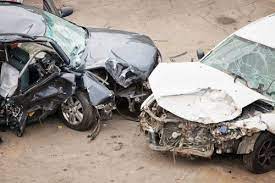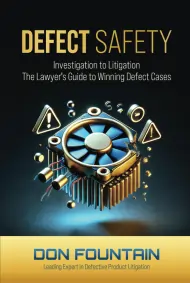Vehicle Safety in 2019: The Five Biggest Automotive Dangers
 The Automotive Issues That Worried Us Most This Year
The Automotive Issues That Worried Us Most This Year
Spontaneous engine fires, dishonest car dealers, and self-driving cars that can’t actually see… here’s a round-up of car safety issues we saw in 2019.
1. A Flaw in the Logic of Self-Driving Cars
Self-driving cars may not ever be a fully viable concept, but many companies are pursuing the fantasy at full speed. They’ve gone so far as to test these cars on the road—with backup drivers behind the wheel to take charge when something goes wrong, but without permits.
In March of 2018, a self-driving Uber fatally struck a woman who was walking her bike across the street. The National Highway Traffic and Safety Administration (NHTSA) recently finished investigating the causes of the incident. In part, the issue was caused by the backup driver’s distraction; she could have intervened had she not been streaming TV on her phone. The underlying error, though, was inherent to the car’s programming.
Self-driving cars don’t see things the same way humans do. They build knowledge by analyzing image sets until they successfully recognize, say, an eighteen-wheeler. Coders define rules to govern their interactions with each obstacle they encounter. In the fatal Uber case, the car’s software failed to identify the pedestrian as a person who was crossing the street on foot with her bike. The car’s software was programmed to not react to an obstacle until it knew what it was to prevent false positives. In this case, because the car couldn’t decide what it was seeing, it delayed until it was too late.
The NHTSA report blamed the lack of recognition on the car’s algorithms; it had not been coded to recognize pedestrians who weren’t in crosswalks. This combination of assumptions and omissions resulted in the loss of a life. It makes us wonder how many other coding mistakes may only be discovered in tragic circumstances.
2. Mercedes-Benz Lags on Airbag Replacements, Under Pressure
More than 41 million cars have been recalled due to Takata faulty airbags that expelled metal shrapnel when deploying. The culprit: excessive interior pressure caused by everything from mishandling of propellant chemicals to humid weather during manufacturing to chewing gum dropped into an inflator.
Mercedes-Benz has lagged in replacing airbags in affected vehicles; though their cars were determined a lower safety risk than some others, customers have reported the postponement of scheduled repairs. The company also faces accusations of:
- Failing to provide a reliable repair timeline for customers
- Allowing dealerships to provide a wide range of excuses for the delays
- Providing contradictory messaging on the risks posed by the recalled airbags
- Replacing airbags for paying customers while those customers looking for free recall assistance that parts were unavailable
The luxury carmaker is now facing a class-action lawsuit from disgruntled owners and lessees. Data on the recalls fully support the action: In 2017, Consumer Reports found that Mercedes-Benz had completed only 2% of recall repairs, vs. 65% completed by Honda. Updated numbers put them at 35%—but with Honda now at 85% completion (with over 17 million cases to handle), they are still far behind the pack. Mercedes-Benz’ reluctance to provide their customers luxury-level service may prompt drivers to do their own research on whether their cars have been recalled.
3. Making a Settlement Instead of Repairs
More than 3,000 cars made by Kia and Hyundai spontaneously caught on fire this decade, resulting in at least one death, which was enough to make the NHTSA open an investigation to the risky car models. It was also the basis for many lawsuits filed against the Hyundai Motor Group, which owns both brands. In October, a class action case resolved with a settlement of $758 million, to be paid out to owners of over $4 million dangerous vehicles.
The settlement follows two recalls in the past four years, many of which involved the part implicated in the settlement: a Theta II gasoline direct injection (GDI) engine. Despite the known danger of engine fires, Hyundai and Kia failed to expand recalls and ensure customers had safe cars.
A cascade of small failures resulted in oil leaks reaching the engine and combusting. The settlement offers engine inspection and repairs and a warning system to prevent further incidents. We hope internal changes will prevent further use of parts known to be faulty.
4. Why Borrow Problems if You Can Buy Them Instead?
Don’t assume that a used car, even if it’s “certified,” is 100% safe for you to drive. There are no federal laws preventing used car dealerships from selling vehicles with open recalls—or even disclosing them to buyers.
After drivers take the cars off the lot, they may have recourse if their car displays issues warned about in a previous recall. However, the point of recalls is to prevent dangerous problems, not provide explanations after tragedies. For some used car drivers, a missed recall results in death. For others (including Mercedes-Benz buyers), long wait times for repairs result in increased anxiety.
Only around 2 in 3 recalls are repaired overall, and that number skews toward newer cars. For vehicles between 6 and 10 years old, that number drops to barely over 1 in 2. Worse, used car dealers are actively fighting efforts to protect consumers by pushing legislation to protect anyone who warns their customers. Their efforts span multiple states and would allow sellers to bury recall notices in multi-page contracts that most people don’t read.
5. Shocking Problems in Electric Vehicles
Tesla leads the field in electric cars, but the batteries in their Model S and Model X cars may have too much power. From Shanghai to Los Angeles, drivers have reported spontaneous battery fires. High-speed accidents have shown that even electric cars are not free of fire hazards, but owners have seen Teslas go up in flame while driving or even parked. The car manufacturer has since pushed an update that throttled the battery charging capacity, causing more customer complaints.
The NHTSA has launched an investigation into the battery combustions, asking Tesla for papers, memos, emails, blueprints, and many other records that may contain information about battery pack development and tests. Tesla owners have also launched a class-action lawsuit, claiming their cars’ resale values have been reduced by the company’s choice to reduce battery range. With a battle set between safety and functionality, is there any way for consumers to win?
Keep Yourself Safe from Hazardous Automakers
If there’s any connection we see between these incidents, it’s that manufacturers often put vehicles on the road before they’re ready. Whether accidental or on purpose, malfunctioning or defective vehicles are a hazard to public safety. If you think poor workmanship contributed to a car accident or other automotive injuries, you may be able to file a suit for compensation.
Do You Need Help?
Call our experienced defective products litigation team at 561-899-2100 or contact us online to see if you have a case.

